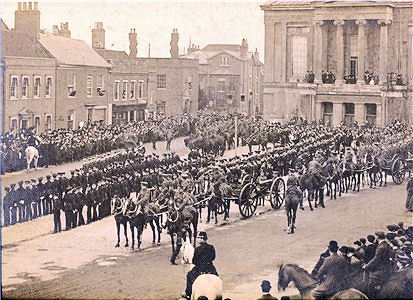|
The Territorial Force in Hertfordshire
|
The Territorial Force was formed in 1908 to form the basis of home defence units, should they been needed. Members were required to attend a camp each year. This would usually mean a fortnight under canvas, accompanied by some hard training plus social activities. There is little doubt that many would have looked on it as an expenses paid holiday from their normal work, as well as a social duty. The Cavalry unit was the Hertfordshire Yeomanry, and its members included Captain Tom Drake of the Bury, and son of Hemel Hempstead's former Mayor, John Ramsey Drake. The Hertfordshire Regiment provided the infantry. "F" Company was made up of men from Hemel Hempstead, Berkhamsted, Tring and Ashridge. It was commanded by Lieutenant Lovel F. Smeathman, son of the Borough Solicitor, Lovel Smeathman, and its headquarters were the Drill Hall in Bury Road. Finally there were Hemel Hempstead men in the 2nd Hertfordshire Battery, Royal Field Artillery, which was based in Watford, and included among its officers Lieutenant Arnold Ward, Unionist MP for West Hertfordshire.
Extract from The London Gunners come to Town
In St Albans the 1st Herts Battery & Ammunition Column (Territorial Force), Royal Field Artillery, 4th East Anglian Brigade, had their riding school, gun park and offices on Harpenden Road, Bernards Heath, close to Heath Farm. In 1914 Captain G. Harland Boweden was commanding, with Battery Sergt. Majors John Ridge & C. Snell, instructors. The Battery can be seen, with their gun, in the above parade picture. Family tradition says that their horses belonged to my grandfather Harry Reynolds, a veterinary surgeon and job master who lived close to the the riding school.
The St Albans members of the Hertfordshire Regiment formed "B" Company and their drill hall was in Hatfield Road, under Captain E. Montague Jones and Colour Sergt. Instructor George Cockings.
Page created October 2005

